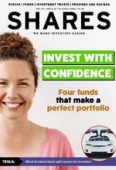Archived article
Please note that tax, investment, pension and ISA rules can change and the information and any views contained in this article may now be inaccurate.
Invest with confidence - four funds which make a perfect portfolio

There are lots of great actively managed funds for investors to choose from but even the best fund managers in the business fail to outperform the market each and every year.
In fact, recent history has taught us that the fortunes of even the most revered professional stock pickers can suffer reversals; this can be for a variety of reasons including investment styles or geographic areas of focus falling out of favour or perhaps through self-inflicted mistakes often brought on by star manager hubris.
First-time investors who don’t have the time or the inclination to research stocks and want to avoid fund manager risk can look at exchange-traded funds (known as ETFs for short or sometimes tracker funds) instead.
LOW COST EXPOSURE
ETFs are a low-cost and simple way to get exposure to major asset classes and create a diversified portfolio. They are cheaper than actively managed investment funds because they simply track an index of stocks and shares or other investments like bonds.
A traditional investment fund, such as a unit trust, has a fund manager deciding what should go in and out of their portfolio and, as a result, their fees tend to be much higher than an ETF.
After all, you’re paying a person to manage the investments. A few actively managed funds do manage to beat their benchmarks consistently, however given the difference higher fees can make to investor returns over time, it is fair to question why you would risk trying to do better than the market by paying for an actively managed fund when you can simply track it through an ETF?
As the new tax year has started, anyone who has yet to build a serious long-term portfolio and has at least 10 years to sit back and watch their investments grow should consider this simpler approach.
Putin’s war in Ukraine and its impact on financial markets has reminded investors of the need to own a diversified portfolio of assets which don’t all move in tandem.
On the assumption a first-time investor has £10,000 to put to work in the markets, we have identified four ETFs that cover the main asset classes and would form the basis for a ready-made portfolio.
We think it would be sensible to put 60% or £6,000 of this pot into developed market equities, another word for stocks and shares, to enable you to share in the growth of some of the world’s highest quality businesses and most beloved brands.
We reckon another 20% should be allocated to emerging market equities. Admittedly, emerging markets are often volatile performers, yet they are capable of generating strong returns over the long run and bring exposure to the growth of the middle classes across developing economies. This makes them a decent option for an investor with time on their side
Our ready-made ETFs portfolio include a 10% exposure to bonds, which are IOU’s issued by governments and companies to investors in return for cash and can help to cushion volatility.
Bonds usually have a fixed life, called the maturity, and offer different levels of interest to bondholders. Given the new economic environment of rising interest rates and high inflation, investors might also want to diversify portfolios beyond stocks and bonds through a 10% allocation to an infrastructure ETF.
Infrastructure assets offer high barriers to entry, relatively inelastic demand and are typically resilient to economic cycles. They also generate relatively stable and predictable cash flows and have a positive correlation to inflation.
FANTASTIC FOUR
Lyxor Core MSCI World ETF
(LCWL) £11.97
Ongoing charge: 0.12%
This is an excellent starting point for an investor seeking diversified exposure to the stock market. It tracks the MSCI World index which is designed to represent the performance of large and mid caps across 23 developed markets countries. The index is a basket of around 1,540 stocks from across the developed world and is dominated by the US through iPhone seller Apple (AAPL:NASDAQ), software giant Microsoft (MSFT:NASDAQ), online shopping-to-cloud computing colossus Amazon (AMZN:NASDAQ), silicon chips star turn Nvidia (NVDA:NASDAQ) and healthcare colossus Johnson & Johnson (JNJ:NYSE). The average market value of stocks in the MSCI World index is knocking on for $37.4 billion and over the past three years this product has delivered an annualised return of 15%, according to data provider Morningstar. To find the ETF on your ISA provider’s platform, type in the code ‘LCWL’.
HSBC MSCI Emerging Markets ETF
(HMEF) 881p
Ongoing charge: 0.15%
Periods of significant volatility in emerging markets sometimes detract from what is a more positive long-term picture for developing economies. These have drivers in place which could make emerging markets exposure attractive for an investor with a long-term investment timeframe. These include a growing middle class which is boosting levels of domestic consumption, larger working age populations than in many Western countries and an increasing role for technology which is helping improve the quality of individual businesses. Our key pick here is HSBC MSCI Emerging Markets ETF (HMEF), which aims to replicate the performance of the MSCI Emerging Markets Index, which is made up of large and mid cap stocks across 25 emerging markets countries with 1,420 constituents. Exposure to this index is on offer for a lowly annual fee of 0.15%. As of 28 February 2022, this low-cost passive’s largest geographical allocation was mainland China at 31.9%, followed by Taiwan (15.73%), South Korea (12.21%), India (12.2%) and Brazil (4.85%). Top holdings include microchip manufacturing titan Taiwan Semiconductor (TSM:NYSE), Chinese internet giants Tencent (0700:HKG) and Alibaba (9988:HKG), South Korean phones-to-semiconductors group Samsung Electronics (005930:KRX), Brazilian mining giant Vale (VALE:NYSE) and Indian business consulting-to-IT titan Infosys (INFY:NSE). To find the ETF on your ISA provider’s platform, type in the code ‘HMEF’.
iShares Core Global Aggregate Bond
UCITS ETF (AGBP) 484.1p
Ongoing charge: 0.1%
Having a degree of exposure to the global fixed income market can help diversify the first-time investor’s portfolio and one sensible low-cost fund option is the iShares Global Aggregate Bond UCITS ETF (AGBP). This passive seeks to track the investment results of the Bloomberg Barclays Global Aggregate Bond Index, which is composed of global investment grade bonds including government, government-related, corporate and securitised bonds, including those issued by the governments of the US, China and Japan, UK, France and Italy. Though the fund has generated a negative net asset value total return of 5.44% year-to-date, the portfolio is diversified across 9,367 holdings. A 1.34% trailing yield is somewhat lower than you would get from a high yield bond portfolio of lower quality bonds, but we prefer the dependability of this bond product, with interest payments underpinned by the security of government issuers and the strong cash flows and fortress balance sheets of corporate issuers ranging from Goldman Sachs (GS:NYSE) and JPMorgan Chase (JPM:NYSE) to HSBC (HSBA), Microsoft and pharma giant Abbvie (ABBV:NYSE). As of 29 March 2022, the fund’s biggest geographical allocation was the US at almost 39%, followed by Japan, China, France, the UK and Germany. To find the ETF on your ISA provider’s platform, type in the code ‘AGBP’.
iShares Global Infrastructure ETF
(INFR) £26.66
Ongoing charge: 0.65%
Known for its reliable long-term income streams, infrastructure has proved a popular area to invest in recent years for its diversification benefits, inflation protection, capacity for steadily rising dividends with modest capital growth. Amid volatile equity and bond markets and the iShares Global Infrastructure ETF has delivered a 3.84% net asset value total return in a volatile year-to-date with 10 year annualised returns of 9.5%, the latter according to Morningstar. This fund seeks to track the performance of the FTSE Global Core Infrastructure Index, which is composed of international infrastructure companies from both developed and emerging countries with a big bias to the US and Canada, has a trailing yield of 1.89% and pays a quarterly dividend. The annual fee is higher than our three other ETFs at 0.65%, which reflects the extra complexity of building an index that tracks infrastructure-related names. The ETFs top holdings include the likes of railroad company Union Pacific (UNP:NYSE), American electric utility Nextera Energy (NEE:NYSE) as well as US mobile phone towers owner Crown Castle (CCI:NYSE). To find the ETF on your ISA provider’s platform, type in the code ‘INFR’.
AND WHY STOP THERE?
This quartet of trackers alone would bring broad-based exposure to some of the major asset classes, although there is no need for an investor to stop there. To further diversify your portfolio, you could use ETFs to obtain exposure to global small caps; smaller firms are often growing much faster than medium or large companies thanks to their innovative products or disruptive services, agility and entrepreneurial management teams.
Though it is at the centre of geopolitical tensions, investors may want to add ETFs that increase their exposure to China, the world’s second biggest economy with an enormous emerging consumer class. Another option is Japan, blessed with a deep stock market that is home to many best-in-class innovative companies that are also becoming more shareholder-friendly.
Low-cost passive funds can also provide you with access the growth potential and resilience of the healthcare sector, while some ETFs track a basket of investments based on commodities such as gold or themes ranging from water and automation and robotics to digital security.
ETFs also offer a way to invest in property, an asset class that could certainly warrant a place in a diversified portfolio given the benefits of capital appreciation potential, coupled with inflation protection and an income stream.
Important information:
These articles are provided by Shares magazine which is published by AJ Bell Media, a part of AJ Bell. Shares is not written by AJ Bell.
Shares is provided for your general information and use and is not a personal recommendation to invest. It is not intended to be relied upon by you in making or not making any investment decisions. The investments referred to in these articles will not be suitable for all investors. If in doubt please seek appropriate independent financial advice.
Investors acting on the information in these articles do so at their own risk and AJ Bell Media and its staff do not accept liability for losses suffered by investors as a result of their investment decisions.
Issue contents
Editor's View
Feature
- Invest with confidence - four funds which make a perfect portfolio
- European shares tend to do well when the US raises interest rates... not this time?
- Why Trainline still faces a big test despite ticket commission win
- Our 2022 stock portfolio rises against a volatile market backdrop
- ESG investing faces a watershed after Russia’s invasion of Ukraine
Great Ideas
- Euromoney set to benefit from strong growth as data-driven businesses excite
- Zoo Digital sets up shop in Scandi-thriller homeland after Bollywood move
- Invest in Rathbones as a wealth management bid frenzy highlights value appeal
- Soaring book sales help publisher Bloomsbury beat sales and profit expectations
- Casual dining group The Fulham Shore offers great scope for growth
- Belvoir continues to enjoy strong tailwinds in the UK property market

 magazine
magazine











